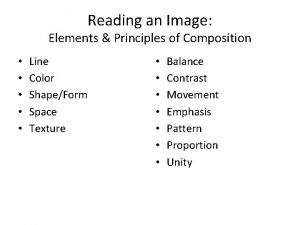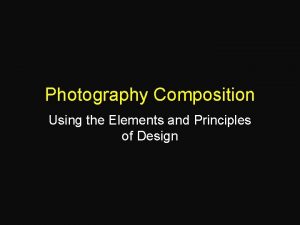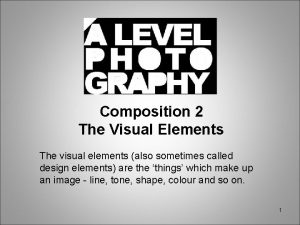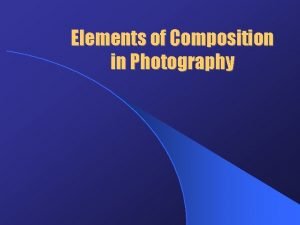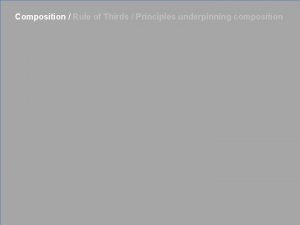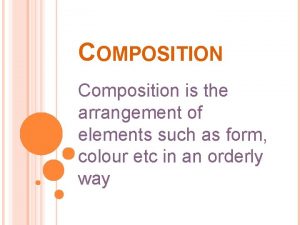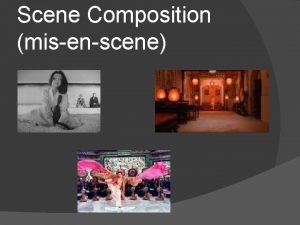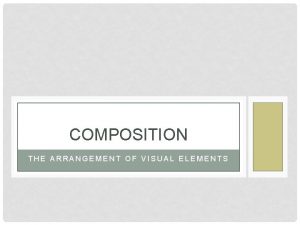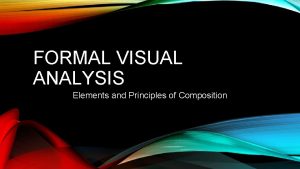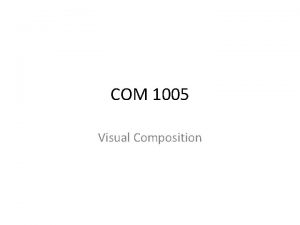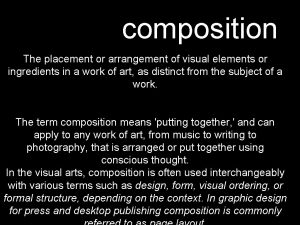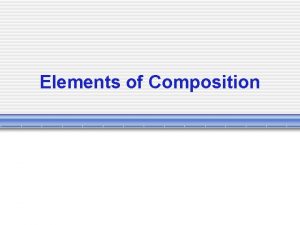Composition 2 The Visual Elements The visual elements


































- Slides: 34

Composition 2 The Visual Elements The visual elements (also sometimes called design elements) are the ‘things’ which make up an image - line, tone, shape, colour and so on. 1

List of Visual Elements Line – actual or implied lines within the composition Shape – areas defined by their edges within the piece. Form – the three dimensional quality of an object or shape – its length, width and depth. Tone – describes the darkness or lightness of a particular area in an image. shading is often used to emphasize the form and an object’s three dimensionality. Colour - hues with their various values, intensity, and saturation Space - the space taken up by objects or the space inbetween objects (sometimes called negative space). Texture - surface qualities of the artwork. 2

Line is a really useful design element when constructing images. Lines are formed by the edges of things when there is an apparent contrast between light and dark areas or between different colours or textures. Lines can also be suggested or implied by patterns or repetition. Henri Cartier Bresson In this image where are the implied lines and where do these lines draw the viewer’s eye? 3

Horizontal And Vertical Lines Chris Monaghan Horizontal lines can suggest a feeling of stability, calmness or tranquillity. Vertical lines can suggest power and strength. 4

Paul Strand Study this urban landscape by Paul Strand. Discuss what Strand might have been saying about the society … would you like to live there? How do the strong vertical lines and dark shadow areas affect your interpretation of the image? 5

Diagonal Lines Diagonal lines tend to be visually dynamic – suggesting movement, a ‘visual tension’ and/or excitement. 6

The model was lying on a bed. How does the photographer make the image more visually ‘dynamic’? Chris Monaghan 7

David Bailey 8

Curved Lines Curved lines often suggest organic (living, breathing) things. 9

Mario Testino Spot the curves in this portrait of an actress. 10

Colour White light is actually made up from just the right mixture of every other colour of light. 11

Primary Colours: Red, Green, Blue. (RGB) Complimentary colours: Cyan, Yellow, Magenta. 12

13

Which of these images uses complimentary, and which uses analogous colours? How does this colour choice help or affect the meaning of each image? 14

Form (The three-dimensionality of the artwork) Masolino, St. Peter Healing a Cripple and the Raising of Tabitha, 1425 The added black lines show the use of a ‘vanishing point’ to create a realistic impression of three dimensional space – commonly referred to as 15 ‘realistic perspective’.

Film still from The Manchurian Candidate How does the photographer suggest three-dimensional space (i. e. depth)? 16

1. Man’s head is larger than woman’s so our brains interpret this as suggesting that he is nearer to the camera than the woman. 2. Background is out of focus suggesting depth 3. The lighting creates shading suggesting three dimensional form 17

What visual element(s) help give this photograph ‘depth’ and a threedimensional character? Fay Godwin 18

Some artists completely rejected the idea that a work of art had always to imitate threedimensional character of the world, as in this collage by Henri Matisse entitled The Snail. Matisse 19

Tone describes the darkness or lightness of a particular area in an image. Very light areas are sometimes called highlights and very dark areas are called shadow areas. Shading (where the tone changes gradually from highlight to shadow) is often used to emphasize the form and three dimensionality of an object. Angus Mc. Bean 20

Balancing The Visual Elements Where is the subject placed in this painting? Images with a centrally located subject are sometimes called ‘formal’ compositions. Having the subject in the middle might create a sense of visual ‘balance’ but can also appear rather boring to the modern eye. Visual balance is achieved by the placement of the visual elements (lines, shapes, colours and so on). Note: Not all images are ‘balanced’. Gainsborough 21

How does the photographer ‘balance’ this image? 22

At first glance this image might not appear balanced, but look more closely …. How does Shomei achieve balance in this unsymmetrical image? Tomatsu Shomei 23

Is this image balanced? If so, how? If not, why not? Chris Monaghan 24

Juxtaposition Juxtoposition is the placing of things close to one another in order to emphasise their difference. What is the major difference being emphasised here? 25

Framing & Cropping Togetherness 26

Framing & Cropping Loneliness This is the same photograph as the previous image but with a different crop. 27

John Hilliard, cause of death, 1974 28

Aspect Ratio (the ‘shape’ of an image) 29

Richard Billingham produced a series of photographs about his parents. He used the amateur 6: 4 aspect ratio shape for his images (just like amateur 6 inch x 4 inch prints). Why might he have chosen this aspect ratio? 30

The Gaze Titian, Venus D’Urbino, 1538 When we look hard at someone else our gaze can sometimes be interpreted as if we are saying “I am the powerful one here”. Manet’s Olympia caused a scandal because he painted a woman in a contemporary setting who seemed by her gaze to be the one with all the power (In 1863 women were meant to do as they were told by men!) Manet, Olympia, 1863 31

Richard Avedon Images in which the subject looks directly at the viewer can have a powerful or disconcerting effect. 32

Composition Summary Visual elements: Some ‘Rules’ of composition 33

Composition Summary Visual elements: Line, Shape, Form, Tone, Colour, Space, Texture Some ‘Rules’ of composition Juxtaposition Symmetry Repetition Rule of thirds Rule of odd and even Rule of space Simplification Balance 34
 Elements and principles of composition
Elements and principles of composition Principles of photography
Principles of photography Vce theatre studies
Vce theatre studies Hát kết hợp bộ gõ cơ thể
Hát kết hợp bộ gõ cơ thể Lp html
Lp html Bổ thể
Bổ thể Tỉ lệ cơ thể trẻ em
Tỉ lệ cơ thể trẻ em Chó sói
Chó sói Chụp tư thế worms-breton
Chụp tư thế worms-breton Hát lên người ơi
Hát lên người ơi Môn thể thao bắt đầu bằng từ chạy
Môn thể thao bắt đầu bằng từ chạy Thế nào là hệ số cao nhất
Thế nào là hệ số cao nhất Các châu lục và đại dương trên thế giới
Các châu lục và đại dương trên thế giới Công thức tính độ biến thiên đông lượng
Công thức tính độ biến thiên đông lượng Trời xanh đây là của chúng ta thể thơ
Trời xanh đây là của chúng ta thể thơ Mật thư anh em như thể tay chân
Mật thư anh em như thể tay chân Phép trừ bù
Phép trừ bù Phản ứng thế ankan
Phản ứng thế ankan Các châu lục và đại dương trên thế giới
Các châu lục và đại dương trên thế giới Thể thơ truyền thống
Thể thơ truyền thống Quá trình desamine hóa có thể tạo ra
Quá trình desamine hóa có thể tạo ra Một số thể thơ truyền thống
Một số thể thơ truyền thống Cái miệng xinh xinh thế chỉ nói điều hay thôi
Cái miệng xinh xinh thế chỉ nói điều hay thôi Vẽ hình chiếu vuông góc của vật thể sau
Vẽ hình chiếu vuông góc của vật thể sau Nguyên nhân của sự mỏi cơ sinh 8
Nguyên nhân của sự mỏi cơ sinh 8 đặc điểm cơ thể của người tối cổ
đặc điểm cơ thể của người tối cổ Ví dụ giọng cùng tên
Ví dụ giọng cùng tên Vẽ hình chiếu đứng bằng cạnh của vật thể
Vẽ hình chiếu đứng bằng cạnh của vật thể Phối cảnh
Phối cảnh Thẻ vin
Thẻ vin đại từ thay thế
đại từ thay thế điện thế nghỉ
điện thế nghỉ Tư thế ngồi viết
Tư thế ngồi viết Diễn thế sinh thái là
Diễn thế sinh thái là Các loại đột biến cấu trúc nhiễm sắc thể
Các loại đột biến cấu trúc nhiễm sắc thể
